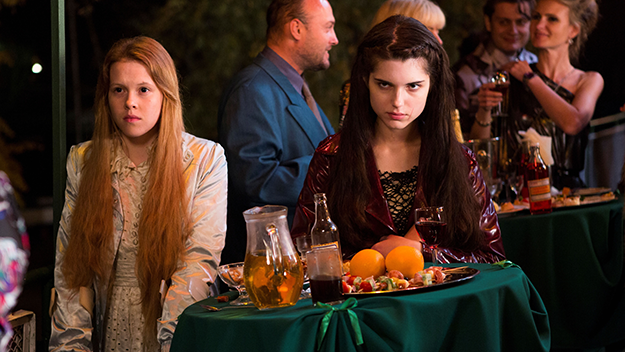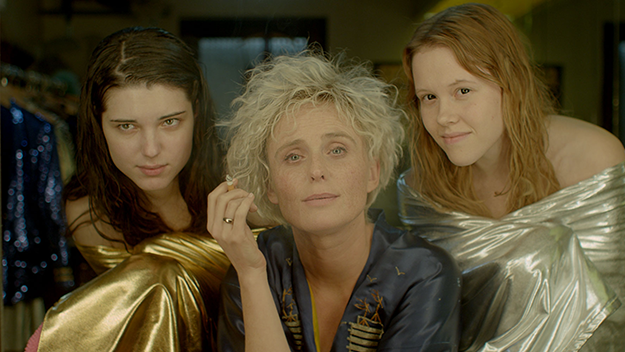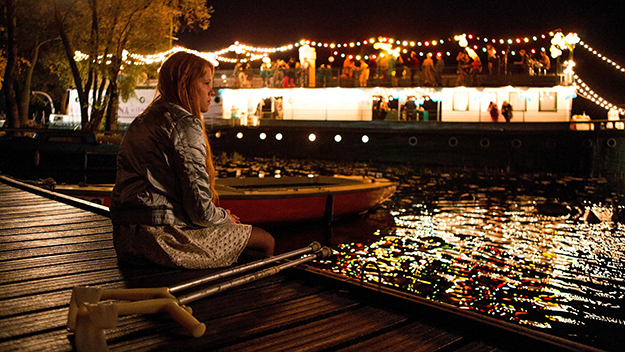Film of the Week: The Lure

So it turns out that there is such a thing as a mermaid fetish—an actual sexual one, involving tails and all, although I have no idea how much it involves full or partial immersion in water, either by the mermaid or by her partner. I wonder how much its popularity owes to Daryl Hannah lolling on a beach in Ron Howard’s Splash (seriously though, can you imagine any Ron Howard film stoking anyone’s desire?), and indeed if that film was a big thing in Eastern Europe (where you imagine it titled something like Szpolsz). In any case, Polish cinema has now taken this particular fantasy to its heart in the form of The Lure—probably the only musical about killer mermaids that you’ll ever see.
Mermaid fetishists will certainly get a kick out of Agnieszka Smoczyńska’s film: the film’s heroines spend a lot of time naked, or half-naked (it’s hard to know how to measure nudity when it’s all scales from the waist down), nor do they bother with those dainty seashell bras that, for some, were probably themselves a potent signifier in Disney’s The Little Mermaid. It should be said, the nudity here is very glossy ’80s centerfold stuff; for a female director, Smoczyńska has made a film that’s remarkably big on cheesecake (or should that be fishcake?).
Originally entitled Corki dancingu, which I think means “daughters of the dance,” Smoczyńska’s film is as bizarre a hybrid as its two heroines: a retro horror musical with a satirical thrust, buckets of blood, and a lurid, morbid eroticism (it’s destined, sooner or later, to appear alongside Phantom of the Paradise in a double bill dedicated to weird musicals set in weirder nightspots). It starts, after a strange animated credit sequence which shows our heroines floating in a cave strewn with human remains (so you’re in no doubt about what you’re getting), with two young aquatic beauties floating in a lake up to their shoulders, looking not unlike the American vamps of John McNaughton’s Wild Things.

One, named Srebrna, or Silver (Marta Mazurek), is clearly the good girl of the two: pale-skinned, big-eyed, ginger-haired, very much resembling a flesh-and-fishbone cousin to Disney’s Ariel; her sister, dark-haired and narrowing her eyes as if with baleful intent, is Zlota, or Gold (Michalina Olszanska). They’re both raptly inspecting a young blond man as he plays the guitar on the beach; he’s nightclub bassist Mietek (Jakub Gierszal), the kind of dashing princely swain that a fairy tale heroine would leave the water for. The pair start crooning seductively to him in close harmony—an eerie, beautiful sound, although the lyrics (“We won’t eat you, my dear…”) might give Mietek pause.
Before long, cut to a nightclub (in reality, the long-closed Club Adria in Warsaw), where the girls have been taken by Mietek’s bandmate, singer Krysia (Kinga Preis). She proudly presents them to the club’s seedy, aging manager (Zygmunt Malanovicz) whose jaw drops when they promptly undress to reveal their naked bodies—human legs, but no genitals or dorsal cleavage. Their most dazzling trick comes when they have water poured on them (you can’t help wondering whether anyone ever considered making a soft-porn version of Gremlins) and they revert to their true form, revealing long, hefty, eel-like tails with a ridge of needle-like spines. They are promptly recruited as signing strippers for the club, and prove to have one up on Esther Williams—wet they’re stars, dry they’re stars too. However, they have one trait that Daryl Hannah’s Madison didn’t have but that they share with the sirens that caused Odysseus to be tied to the mast: they are literally man-eaters, as we see when Gold lolls in a bathtub, her smile revealing two rows of Moray eel fangs.
There is a linear narrative here, although I have to say it lost me—the film doesn’t seem to proceed with a great sense of consequence, but barrels crazily through a series of songs and flashy numbers that at times suggests that Smoczyńska may be parodying Polish music video of the ’80s. The songs are by sisters Barbara and Zuzanna Wrońska of indie
act Ballady i Romanse, or Ballads and Romance; their reminiscences of Club Adria, where their parents were performers, inspired the film. As presented in the subtitles, the lyrics are madcap stuff, and you have to salute the translator for catching what one imagines is the goofy tone of the original. “Holy moly, bitter tastes can be delicious,” goes one song; another contains the priceless couplet, “They promised frutti di mare / Now we’re feeling sorry,” while in yet another, a raspy-voiced chanteuse laments, “I need my glucose / My hair feels like viscose.” The music runs from the mermaids’ signature song—which echoes those Bulgarian female choirs that became a cult in the ’80s—to agitated electro-punk, via period electro-disco, sometimes with ultra-cheap Casio rhythms, sometimes with distinctly modern Auto-Tune embellishment.

The Lure manages to look at once oddly shabby in its dominant register of kitsch—perhaps because its prime location is a genuine club of the Communist era—and seductively glamorous, in a fond retro way. More than anything, the film’s visual signature reminded me of ’80s French cinema, the cinéma du look spearheaded by Jean-Jacques Beineix’s Diva, while the myth-as-musical concept reminded me a little of a film I’d rather forget, the great Jacques Demy’s awkwardly modish Orpheus story Parking
(85). The manic pace at which the songs tumble out also recalls Hedwig and the Angry Inch (another retro-punk musical about the integrity of the sexual body). And there’s just a hint of long-forgotten British movie Breaking Glass (1980, Brian Gibson), a vehicle for briefly famous postpunk diva Hazel O’Connor; I now have reason to suspect it may have been big in Poland in its day. Visually, The Lure is something, with DP Jakub Kijowski lighting everything to look as artificial as possible, and playing up the aquatic theme by drenching the frame in shades of glaucous green and salmon pink.
The Lure is one of those perverse, intense, facetious yet perfectly earnest films that never stops having a good time—although its relentlessness means that the viewer might feel inclined to bow out of the festivities every now and then. It all feels very fragmentary, a torrent of bright ideas for the hell of it, like the scene in which the sisters are tossed into a river wrapped in carpets; they promptly return, and it’s never mentioned again. Perhaps Smoczyńska and writer Roberto Bolesto just thought it would be cool to have a scene in which they get tossed into a river, then another in which they sashay back to the club
in matching raincoats.
Throughout you get odd, not always narratively transparent cameos, like the female copper (Katarzina Herman) who does a Sapphic, gun-toting pas de deux with Gold, and merman Triton (Marcin Kowalczyk) who sports twin scars on his forehead, where horns used to be—an aquatic cousin of Mike Mignola’s and Guillermo del Toro’s Hellboy. Running through it all like an underground river is the transformative myth of Hans Christian Andersen’s Little Mermaid story—here, Silver isn’t just interested in having human legs, but a woman’s genitals, although I suppose that was always the implicit point of the story. Thank goodness the Andersen subtext is there to guide us, otherwise The Lure would be hard to make head or tail of.
Jonathan Romney is a contributing editor to Film Comment and writes its Film of the Week column. He is a member of the London Film Critics Circle.



